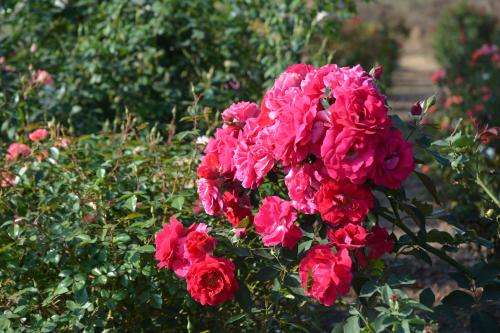Texas roses must be 'on' year round to make the cut

It's late autumn, and most of the blossom-laden plants that colored summer are fading.
But seasonal changes offer no excuse for roses in experimental plots around Texas. They had better be loaded with colorful, fragrant autumn blooms and healthy green foliage if they ever expect to be planted in someone's yard. That's the contention of picky rose breeder Dr. David Byrne, Texas A&M AgriLife Research scientist based in College Station.
"The first thing I select for is a lot of flowers, because that's what a gardener wants," Byrne said as he paced one of his test plots. "Gardeners don't just want one or two pretty flowers, they want hundreds. We look for a plant that's at least 50 percent covered with flowers."
Byrne and a team of graduate students made their third trip this year to the Ralph Moore Collection Rose Garden near Mansfield recently to see how the plants were blooming after similar visits last spring and during the extreme heat of August.
The collection was a gift of Moore, who opened a nursery in Visalia, California in 1937 and bred hundreds of roses to achieve unique colors, shapes, sizes and fragrances until he closed his Sequoia Nursery in 2008. Because he knew of Byrne's research, Moore donated the collection to Texas A&M for further studies and use for variety development before he died in 2009 at the age of 102.
For Byrne, the collection offered the beauty that was needed for his hardy breeding lines, which tended to have less showy flowers.
Walking among the rows and scoring each plant on a variety of traits, Byrne explained how the California-derived specimens may blend with his stock to become varieties suitable for Texas.
"We started with over 1,000 plants here (near Mansfield), and over the years we've eliminated some because they were not well adapted," said Byrne, who also is professor of horticultural sciences at Texas A&M University. "These plants were originally developed in California in the San Joaquin Valley where it's hot in the day,but they have cool nights, which makes a big difference in a plant's ability to grow well."
The Moore collection, therefore, was bred primarily for beautiful, abundant blossoms, not resistance and tolerance to adversity, he said.
"Though a lot of the Moore roses really were not selected for heat tolerance, surprisingly quite a few are," he said. "We've been very happy to identify maybe 15 percent of the collection that really produces nice flowers in the summertime. From these, we are making crosses with the more resistant roses that we have developed at Texas A&M.
"We come to the trial plot in the springtime when it's cool and evaluate the flowering intensity, the flower quality and overall growth of the plant, then in August when it's usually 95 to 100 degrees, and then do another evaluation in October to consider the same parameters. By comparing the summer versus the fall and spring, we can determine which ones are more resistant to disease and more tolerant of the heat," Byrne said.
Specifically, Byrne is breeding for blackspot resistance, which tends to be more of a problem in humid parts of Texas than in California.
"We developed some of these (blackspot and heat tolerant strains) to a point where we can use them as breeding material and cross with the Moore material," he said. "We are up to our second cycle on this type of crossing, and we are going to select ones that have good adaptation as well as nice flowers—and a lot of flowers—to develop into new varieties.
"What we've seen is that some really do well during the spring and look really gorgeous, but in the summer there are no flowers," he said. "But in the fall, they recover fully. They've done that for four years consistently. So, we're looking for things that have a flower intensity of what I'd call a five, which is 50 percent of the plant covered with flowers all year round. And then, of course, we want good flowers and lots of other characteristics as well.
"Going forward, we will try to combine those two lines of breeding material and have better flowers that are heat tolerant with blackspot resistance and will do well in the garden," he said. "And considering that in developing a new rose plant, one cycle is five years, it will take several cycles to get there."
Provided by Texas A&M University


















